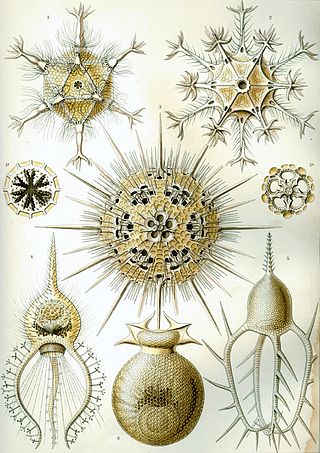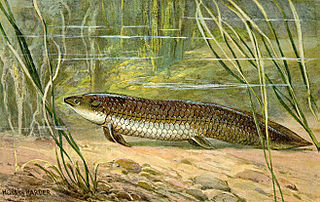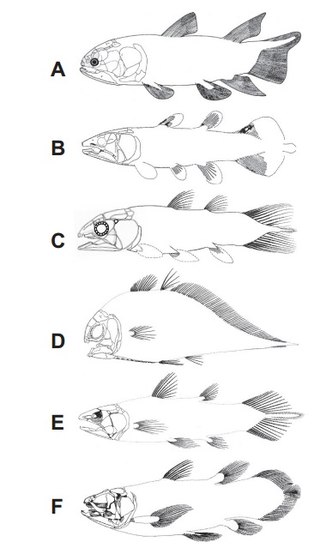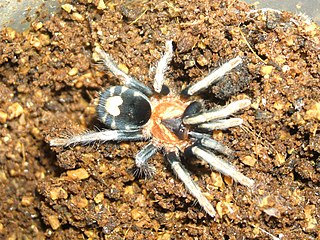
Caenorhabditis elegans is a free-living transparent nematode about 1 mm in length that lives in temperate soil environments. It is the type species of its genus. The name is a blend of the Greek caeno- (recent), rhabditis (rod-like) and Latin elegans (elegant). In 1900, Maupas initially named it Rhabditides elegans. Osche placed it in the subgenus Caenorhabditis in 1952, and in 1955, Dougherty raised Caenorhabditis to the status of genus.

The Noctilucales are an order of marine dinoflagellates. They differ from most others in that the mature cell is diploid and its nucleus does not show a dinokaryotic organization. They show gametic meiosis.

Phaeodarea or Phaeodaria is a group of amoeboid cercozoan organisms. They are traditionally considered radiolarians, but in molecular trees do not appear to be close relatives of the other groups, and are instead placed among the Cercozoa. They are distinguished by the structure of their central capsule and by the presence of a phaeodium, an aggregate of waste particles within the cell.

Ceratodus is an extinct genus of lungfish. It has been described as a "catch all", and a "form genus" used to refer to the remains of a variety of lungfish belonging to the extinct family Ceratodontidae. Fossil evidence dates back to the Early Triassic. A wide range of fossil species from different time periods have been found around the world in places such as the United States, Argentina, Greenland, England, Germany, Egypt, Madagascar, China, and Australia. Ceratodus is believed to have become extinct sometime around the beginning of the Eocene Epoch.
Abiotrophia is a genus of lactic acid bacteria, a family in the phylum Bacillota (Bacteria).

The elegant water shrew is a species of mammal in the subfamily Soricinae of the family Soricidae. It is the only species within the genus Nectogale. It lives in Sikkim and China.

Bacteriastrum is a genus of diatoms in family Chaetocerotaceae. There are more than 30 described species in genus Bacteriastrum, but many of these are not currently accepted, and new species are still added to the genus. The type species for the genus is Bacteriastrum furcatum Shadbolt.

Chonetes is an extinct genus of brachiopods. It ranged from the Late Ordovician to the Middle Jurassic.

Rhabdoderma is an extinct genus of coelacanth fish in the class Sarcopterygii. It lived in the Carboniferous and Early Triassic (Induan), and its fossils have been found in Europe, Madagascar and North America. The type species was originally described as Coelacanthus elegans.

Dinophyceae is a class of dinoflagellates.

Cyriocosmus elegans is a spider species in the genus Cyriocosmus and the family Theraphosidae (tarantulas) found in Venezuela, Trinidad and Tobago.

Jinfengopteryginae is a subfamily of bird-like theropod dinosaurs known from the Cretaceous of Eurasia. This group includes relatively few genera, with members discovered in 2005 but the name erected in 2012. Like other troodontids, this group of dinosaurs resided in the Paraves potentially close to the Avialae.
Cyrenella is a genus of fungi in the class Cystobasidiomycetes, containing the single species Cyrenella elegans.
Rhodoplanes is a phototrophic genus of bacteria. Rhodoplanes produces hopanoids like diplopterol, tetrahymanol, 2-methyldiplopterol, 2-methyltetrahymanol, bacteriohopanetetrol, bacteriohopaneaminotriol and carotenoids like spirilloxanthin, rhodopin, anhydrorhodovibrin, 1,1′-dihydroxylycopene and 3,4,3′,4′-tetrahydrospirilloxanthin
Cheiromoniliophora elegans is a species of fungus in the order Pleosporales in the class Dothideomycetes. It is the type species of its genus.
Cruoriella elegans is a species of red algae in the family Peyssonneliaceae. It is found in the southern islands of Japan.

Bauruemys is an extinct genus of turtles in the family Podocnemididae.
Ichthyodinium is a monotypic genus of dinoflagellates in the family Dinophysaceae. Ichthyodinium chabelardi (/ɪkθioʊˈdɪniəm/) is currently the sole described species of the genus.
Kofoidinium is a genus of dinoflagellates belonging to the family Kofoidiniaceae. It only contains one known species,
Apodinium is a genus of dinoflagellates belonging to the family Apodiniaceae.











